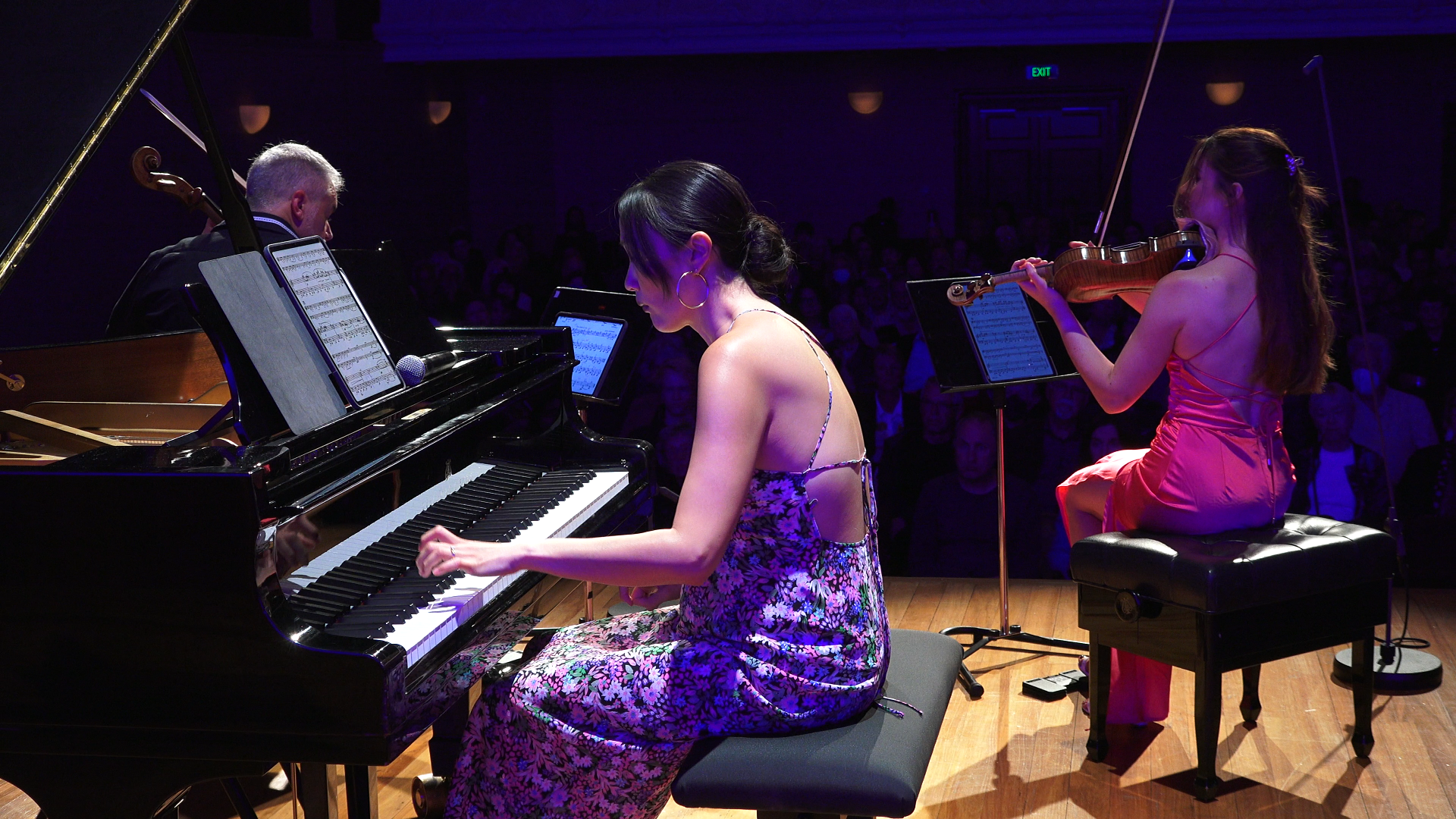Pain in the Arse (2012) – 8′
O Cambodia (2011) – 20′
Fire in the Belly (2006) – 7′
Arranged for NZTrio:
Tribute to the Blues: Mary Lou’s Dreams and John Lee’s Pluck (2008) – c. 8′
Rainforest II: Hunting song, Returning from a hunt, Lament – c. 9’
Pain in the Arse (2012) – 8′
O Cambodia (2011) – 20′
Fire in the Belly (2006) – 7′
Arranged for NZTrio:
Tribute to the Blues: Mary Lou’s Dreams and John Lee’s Pluck (2008) – c. 8′
Rainforest II: Hunting song, Returning from a hunt, Lament – c. 9’
Pain in the Arse:
A few years ago, the Kronos Quartet told me an amusing story. As they descended in a hotel lift on their way to rehearse a piece of mine, one member of the quartet asked another, ‘Oh, did you remember to bring the Body Parts?’ A startled silence fell on the other passengers in the lift…Well, parts of the body are a rich source of metaphor. Hence the concept for this trio, to which yet more movements will be added as time passes.
First came Fire in the Belly, commissioned by NZTrio in 2007. The new movement, completed in February 2012, is Pain in the Arse, that annoying someone or something that causes us extreme irritation or frustration. But there are also literal meanings: rectal pain caused by a fissure, an abscess, infection, or most commonly, by haemorrhoids… actually, I find the business of composing ‘a bit of a pain’, meaning that it’s hard work! On the other hand, the rewards in the end can make it all worthwhile – such as having my music performed by the dedicated and wonderfully spirited NZTrio!
O Cambodia is a collection of the three following works:
HIM Sophy THE FIRST STRIKE
This composition was inspired by an experience Him Sophy had in 1976 when he was 13 years old. He was in a field digging the land for planting rice, and witnessed the head Khmer Rouge security officer suddenly strike a fellow worker with a large stick. It was very frightening. A friend told him that the man who was struck was one of the “April 17 People”, former urban dwellers whom the regime considered suspect on account of their background. A little later he met a girl who had also been working in that rice field that day, and she told him that the person who had been beaten was in fact her father and that he had disappeared. She and her family never found his body.
The First Strike was commissioned by Marilyn Garson (in celebration of Anne, Lily, Pearl and Sol Hirsch) and two anonymous donors.
Jack Body O CAMBODIA
The sung and spoken texts of Jack’s work are drawn from two sources:
‘With (all-seeing) eyes like a pineapple’ and ‘The blood screams, the skin claims (retribution)’.
The musical material is also derived from several sources.
This composition was commissioned for the O CAMBODIA programme with funding from Creative New Zealand.
Fire in the Belly:
Jack’s words: “Fire in the belly is that energy that impels us to do things, make things, and to act with urgency and a sense of necessity. It is one important source of creative energy, and without it art can be flaccid and dull. It is what teenagers tend to have a lot of, and what aged folk like me need to try to recapture from time to time!. The work was commissioned by NZTrio with funding from Creative NZ and I was delighted to receive this invitation from an ensemble which has such a fantastic commitment to NZ music.”
Tribute to the Blues: Mary Lou’s Dreams and John Lee’s Pluck
Jack’s words: “Why did I choose to mine the heritage of blues? The simple answer is because I know so little about the genre, and this was my chance to broaden my horizons, by transcribing five very contrasted pieces. Although to the uninitiated blues can sound formulaic and repetitive, in the hands of great performers the genre can express raw emotion in ways that other musical genres struggle to do.
These transcriptions of classic blues recordings try to capture some of the individual character of two great blues musicians – Mary-Lou Williams and John Lee Hooker. Mary-Lou Williams (1910-81) made a huge contribution to jazz as a pianist, composer, arranger and educator. She provided scores and arrangements for such greats as Duke Ellington and Dizzy Gillespie. Her influence on music was recognised with several honorary doctorates from American universities. John Lee Hooker (1917–2001), who has been described as the world’s greatest blues singer, influenced several generations of jazz musicians. Time Magazine wrote of him: ‘He doesn’t just sing the blues…doesn’t just play the blues…he IS the blues.’ “
Tribute to the Blues, in its original three-movement version for four instruments, was commissioned for the Amici Ensemble by the Waikanae Chamber Music Society, with funding from Creative New Zealand. In 2008, the composer arranged May Lou’s Dreams and John Lee’s Pluck for NZTrio to perform during a tour to Indonesia, featuring a programme of his music.
Rainforest II: Hunting song, Returning from a hunt, Lament (piano trio) – c. 9’
Jack’s words: “The music of Pygmy groups of the rain forests of Central Africa is among the most beguiling of the world’s music traditions, with its characteristic melodic leaps, rich polyphonies, and flights of astonishing virtuosity. The ancient Egyptians greatly admired the musicality of the Pygmies, and Pygmy musicians were often attached to the courts of the Pharaohs. These transcriptions/reinterpretations are based on Simha Arom’s recordings of the music of two Pygmy groups, the Aka and Ba-Benzele.”

